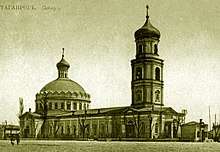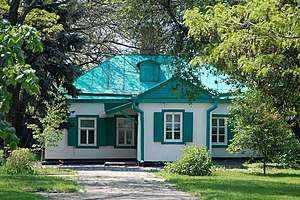Alferaki Palace
Alferaki Palace is a museum in Taganrog, Russia, originally the home of the wealthy merchant Nikolay Alferaki. It was built in 1848 by the architect Andrei Stackenschneider on Frunze Street (formerly Katolicheskaya), in downtown Taganrog.
Историко-краеведческий музей г.Таганрога (дворец Н.Д.Алфераки) | |
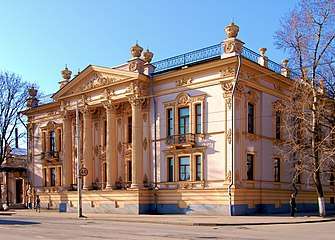 Alferaki Palace | |
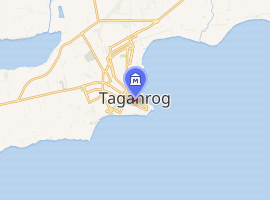
| |
| Established | 1848, 1927(as museum) |
|---|---|
| Location | Ulitsa Frunze 41, Taganrog |
| Type | Museum of local history |
| Director | Mrs. Galina Alexandrovna Krupnitskaya (Russian: Крупницкая, Галина Александровна) |
| Public transit access | "Museum of Local Lore and History" Tram Stop |
The building is decorated with a portal featuring four Corinthian columns and stucco moulding in the baroque style. A suite of rooms was created inside, along with a spacious music hall with a ceiling-painting.
History
The first owners of the palace were Nikos Alferakis, who was born in Taganrog and his family. Mikhail Shchepkin stayed in Alferaki Palace in July 1863. In the 1870s, after the Alferaki family went bankrupt, the palace was sold to the Greek merchant Negroponte. Its garden was sold to the merchant community. It re-opened as the Commercial Assembly. Anton Chekhov (as a student of The Boys Gymnasium) visited concerts given at the commercial club in 1876, and he later mentioned the palace in his stories Ionych, Mask and My life.
From February to April 1918, the mansion became the headquarters of the Soviet Workers' council of Taganrog.
Later during occupation in 1918 it housed the German war hospital, and in 1919 – Anton Ivanovich Denikin's staff.
After the establishment of Soviet power in Taganrog, the building accommodated various institutions. After 1927 it housed the Museum of Regional Studies (founded in 1898 by Anton Chekhov).
During the Occupation of Taganrog, the whole collection of Russian art, as well as 339 other art objects were looted by German occupation authorities[1][2] .
Alferaki Palace was renovated in 1991–1996 and is now open to public as the Museum of Regional Studies, though it is more commonly known under the name Alferaki Palace.
The spacious hall with amazing acoustics is also used by the Municipality for official ceremonies, especially the Mayor of Taganrog's annual ceremony to honor the best school graduates.
Views of the palace
 Commercial Assembly in the former Alferaki's mansion, early 20th century
Commercial Assembly in the former Alferaki's mansion, early 20th century Photo of the late 19th century.
Photo of the late 19th century. Photo taken in 2006.
Photo taken in 2006. Gates into the Alferaki Palace yard (from Ulitsa Frunze), photo taken in 2006.
Gates into the Alferaki Palace yard (from Ulitsa Frunze), photo taken in 2006.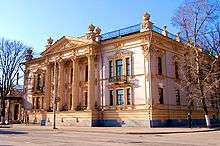 Photo taken in 2008.
Photo taken in 2008.
Museum's collection
The basis of museum collections is formed with funds related to famous historical or artistic personalities, including authentic personal belongings of the Russian tsars Alexander I of Russia and Peter I of Russia, playwright and poet Nestor Kukolnik, the founder of Russian heraldry Alexander Lakier, the great actress Faina Ranevskaya, author of children's books Ivan Vasilenko, romantic composer Achilles Alferaki, general Paul von Rennenkampf and many more.
 The stateroom (assembly hall) at the Alferaki Palace with portraits of governors and mayors of Taganrog of 19th century.
The stateroom (assembly hall) at the Alferaki Palace with portraits of governors and mayors of Taganrog of 19th century.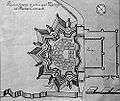 The project of the Saint Trinity fortress and seaport of Taganrog (established by Austrian engineer Baron Ernst Friedrich von Borgsdorf).
The project of the Saint Trinity fortress and seaport of Taganrog (established by Austrian engineer Baron Ernst Friedrich von Borgsdorf)._by_anonymous_(19_c.%2C_Alferaki_Palace%2C_Taganrog).jpg) Portrait of Yelizaveta Alexeevna (fragment, slightly cropped), born Louise of Baden, spouse of Alexander I of Russia.
Portrait of Yelizaveta Alexeevna (fragment, slightly cropped), born Louise of Baden, spouse of Alexander I of Russia. Portrait of Mayor-General Alexandre Remi, friend of Mikhail Lermontov
Portrait of Mayor-General Alexandre Remi, friend of Mikhail Lermontov Portrait of Ioannis Varvakis attributed to Vladimir Borovikovsky
Portrait of Ioannis Varvakis attributed to Vladimir Borovikovsky Governor Balthasar von Campenhausen
Governor Balthasar von Campenhausen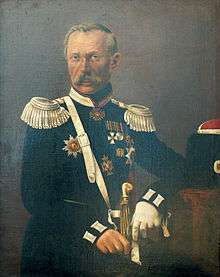 General Ivan Krasnov.
General Ivan Krasnov. Lootings of general Paul von Rennenkampf.
Lootings of general Paul von Rennenkampf.
See also
- Achilles Alferaki
- Sergei Alphéraky
- History of Taganrog
- List of people in Taganrog
External links
- (in English) Taganrog Arts & Culture Council, Municipal website
References
- Taganrog Encyclopedia (Энциклопедия Таганрога), 2nd edition, Taganrog, 2003
- Утраченные культурные ценности Российской Федерации / Cводный каталог утраченных ценностей Российской Федерации / Том 13. Таганрогский государственный литературный и историко-архитектурный музей-заповедник (утрачено предметов – 339)
- Cводный каталог культурных ценностей российской Федерации, похищенных и утраченных в период второй мировой войны. Том 13.
